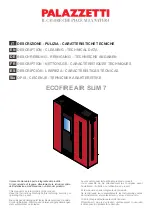
20
7038-227C
August
13,
2018
57ST-ACC-C
Formation and Need For Removal
: When wood is burned
slowly, it produces tar and other organic vapors which
combine with expelled moisture to form creosote.
The creosote vapors condense in the relatively cool
chimney flue of a newly-started or a slow-burning fire. As
a result, creosote residue accumulates on the flue lining.
When ignited, this creosote creates an extremely hot fire
which may damage the chimney or even destroy the house.
The chimney connector and chimney should be inspected
once every 2 months during the heating season to
determine if a creosote or soot buildup has occurred. If
creosote or soot has accumulated, it should be removed to
reduce the risk of a chimney fire.
WARNING
Fire Risk.
Prevent creosote buildup.
•
Inspect chimney connector and chimney once
every two months during heating season.
•
Remove creosote to reduce risk of chimney
fire.
•
Ignited creosote is extremely HOT.
Fire Risk.
•
Do not use chimney cleaners or flame
colorants in your appliance. Will corrode
chimney pipe.
WARNING
CAUTION
•
Do not use polishes with abrasives. It will scratch
plated surfaces.
Fire Risk.
Disposal of Ashes
• Ashes should be placed in metal container
with tight fitting lid.
• Do not place metal container on combustible
surface.
• Ashes should be retained in closed container
until all cinders have thoroughly cooled.
WARNING
CAUTION
•
Do not use polishes with abrasives. It will scratch
surfaces.
2. Cleaning Plated Surfaces
• Frequency:
Prior to first burn and then as desired
• By:
Homeowner
Clean all the fingerprints and oils from plated surfaces
BEFORE
firing the appliance for the first time. If not
cleaned properly before lighting your first fire, the oils can
cause permanent markings on the plating.
After the plating is cured, the oils will not affect the finish
and little maintenance is required. Wipe clean as needed.
3. Disposal of Ashes
• Frequency:
When ash is within 1-3/4 in. (44mm) of
firebox lip
• By:
Homeowner
Ashes should be placed in a metal container with a tight
fitting lid. The closed container of ashes should be placed
on a non-combustible floor or on the ground, well away
from all combustible materials, pending final disposal. If the
ashes are disposed of by burial in soil or otherwise locally
dispersed, they should be retained in the closed container
until all cinders have thoroughly cooled.
4. Glass Cleaning
• Frequency:
As desired
• By:
Homeowner
Clean glass with a non-abrasive glass cleaner. Abrasive
cleaners may scratch and cause glass to crack.
If the
deposits on the glass are not very heavy, normal glass
cleaners work well. Heavier deposits may be removed by
using a damp cloth dipped in wood ashes or by using a
commercially available oven cleaner.
After using an oven cleaner, it is advisable to remove any
residue with a glass cleaner or soap and water. Oven
cleaner left on during the next firing can permanently stain
the glass and damage the finish on metal surfaces.
A portion of the combustion air entering the firebox is
deflected down over the inside of the door glass. This
air flow “washes” the glass, helping to keep smoke from
adhering to its surface.
When operated at a low burn rate, less air will be flowing
over the glass and the smokey, relatively cool condition of a
low fire will cause the glass to become coated.
Operating the appliance with the Burn Rate Air Control and
Start-Up Air Control all the way open for 30-45 minutes
should remove the built up coating.















































